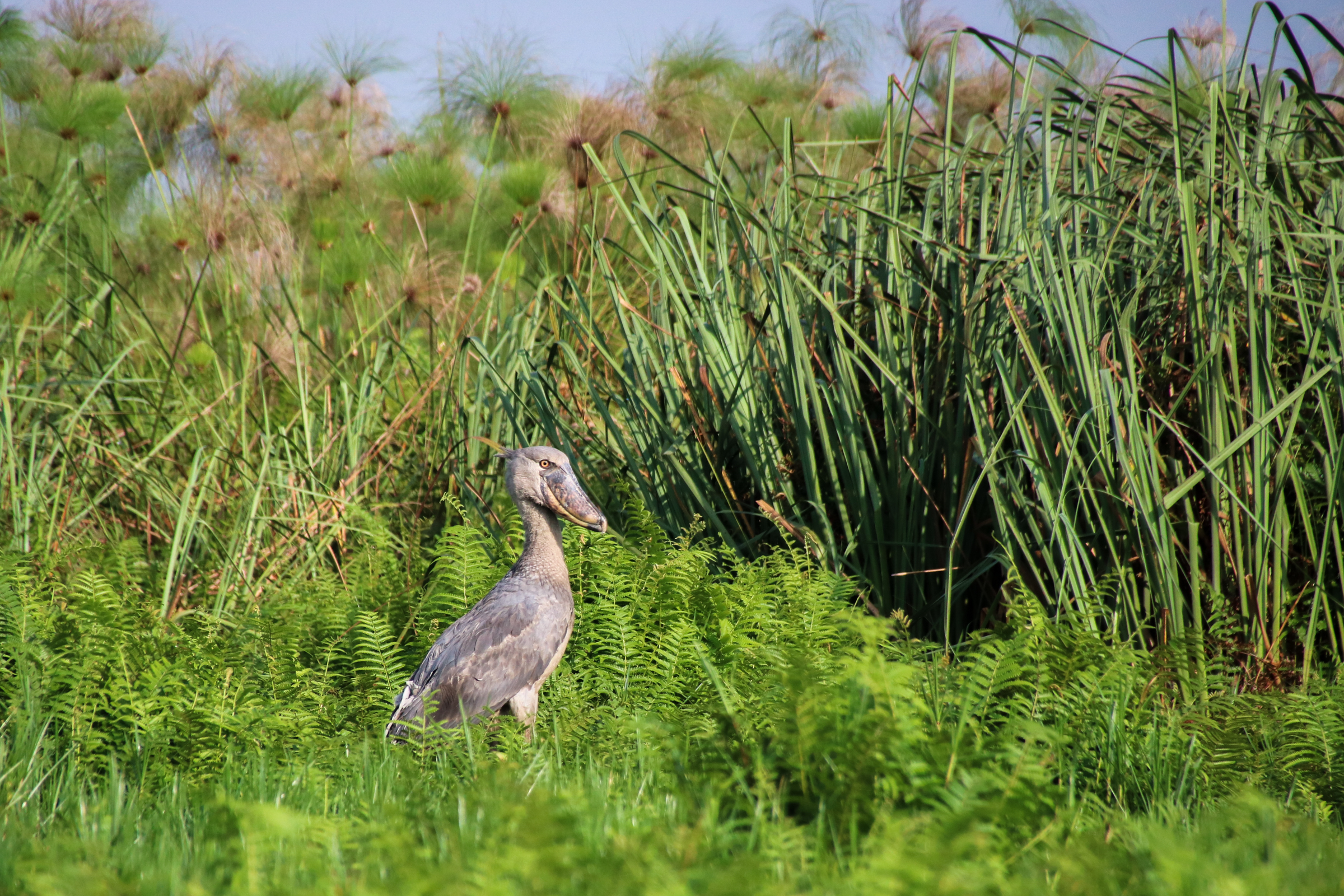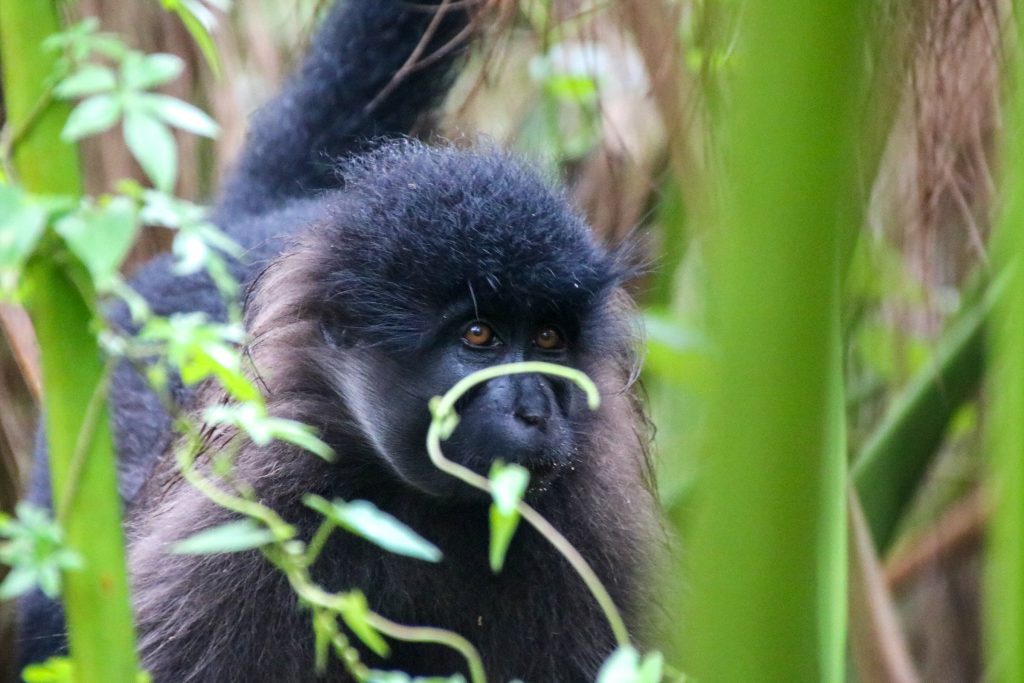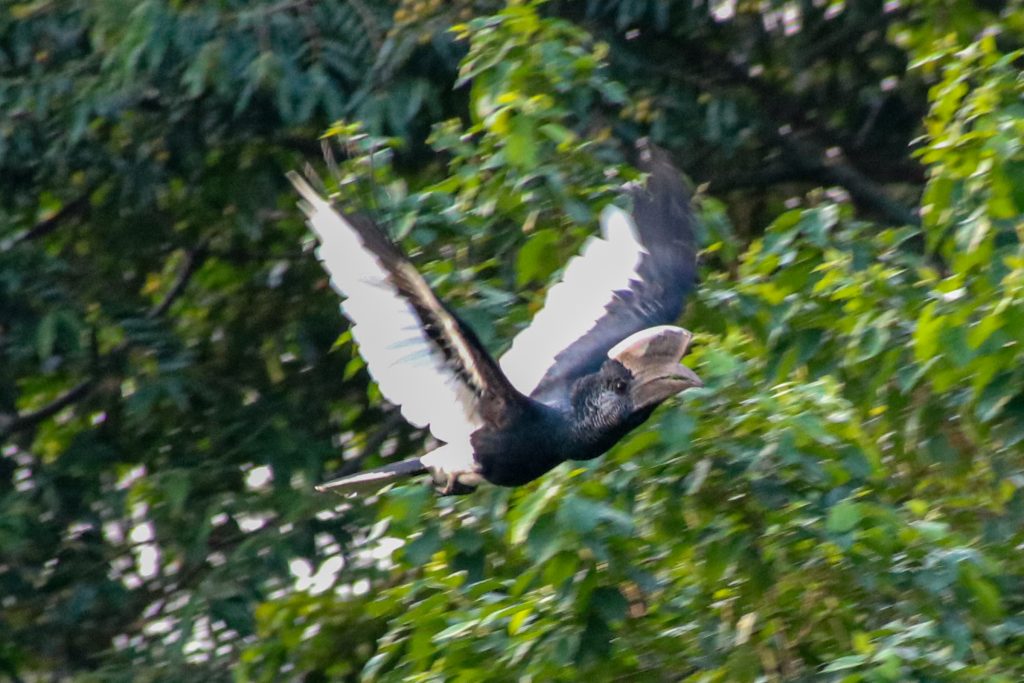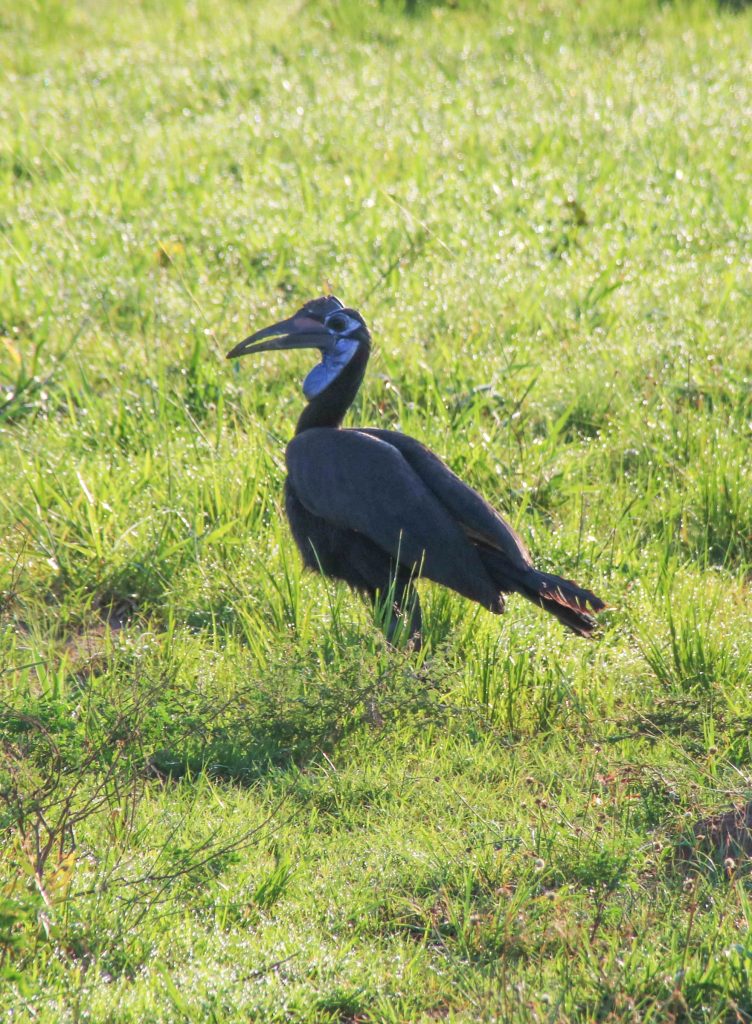One of the main reasons for us to visit Uganda was seeing African wildlife. Though the country’s numbers of wild animals declined severely in 1970s and 1980s, nature is winning again. With several top class wildparks and a wide range of diverse landscapes Uganda is a top destination to spot African wildlife as well as some particular highlights such as to see shoebill storks in the wild. In addition, Uganda is a great destination to see primates – for many the mountain gorillas are top of the list, but for us it was the sheer diversity of species. Read this article now to find out where to find shoebill storks and 50+ other animals we saw while travelling the Pearl of Africa.

Top spots to see wildlife in Uganda
Uganda has an impressive ten national parks and more than two dozen wildlife reserves and sanctuaries. The country’s landscapes are part of the Great African Rift Valley and sits right in a fork between the Eastern and Western rifts. We visited five national parks and a few other wildlife areas. The top spots to see wildlife are:
- Murchison Falls National Park, both north of the Nile and to the south in Kaniyo Pabidi Forest – a mix of savannah, hilly country, dry forests, river banks, river delta, lake shores and rain forests. This is quite the complete package of wildlife viewing as you’d expect it from Eastern Africa with the addition of the large Nile river falls as a spectacular extra. Giraffe, lions, elephants, kob antelopes, chimpanzees, abundant bird life (including shoebill storks, bit not guaranteed) and more
- Queen Elizabeth National Park, in particular Kazinga Channel and the Ishasha Sector – big lakes, crater lakes, river banks and large flat open grasslands, and some savannah country towards the Ishasha sector – villages and settlements are part of the patchwork region of QENP, which creates tension between wildlife conservation and daily life of the people living in or near the national park. Elephants, tree-climbing lions, large buffalo herds, leopards (we didn’t see though), many antelope species and more birds than you can count.

- The Fort Portal region including the crater lake area, bu particularly Kibale National Park and local spots such as the Bigodi Nature Walk – a land of hills, mountains, forests and agricultural land, villages spread out through the hills, as well as tea plantations. Primates (monkeys) and bird life.
- Mgahinga Gorilla National Park, encompassing the Ugandan side of the volcanoes on the tri-border of Rwanda, DR Congo and Uganda – a mountain region with villages up to the edge of the national park, the park itself densely forested on the steep inclines of the vulcanoes. Golden monkeys, chameleons and, of course, gorillas (we didn;t see
- Ziwa Rhino Sanctuary, a place set apart to re-introduce rhinos to Uganda. The wildlife program is highly sucsesful with now more than 20 rhinos from an original five animals. The sanctuary provides much work s well as tourism education to local communities. There are also dedicated shoebill tours here (we didn’t do).
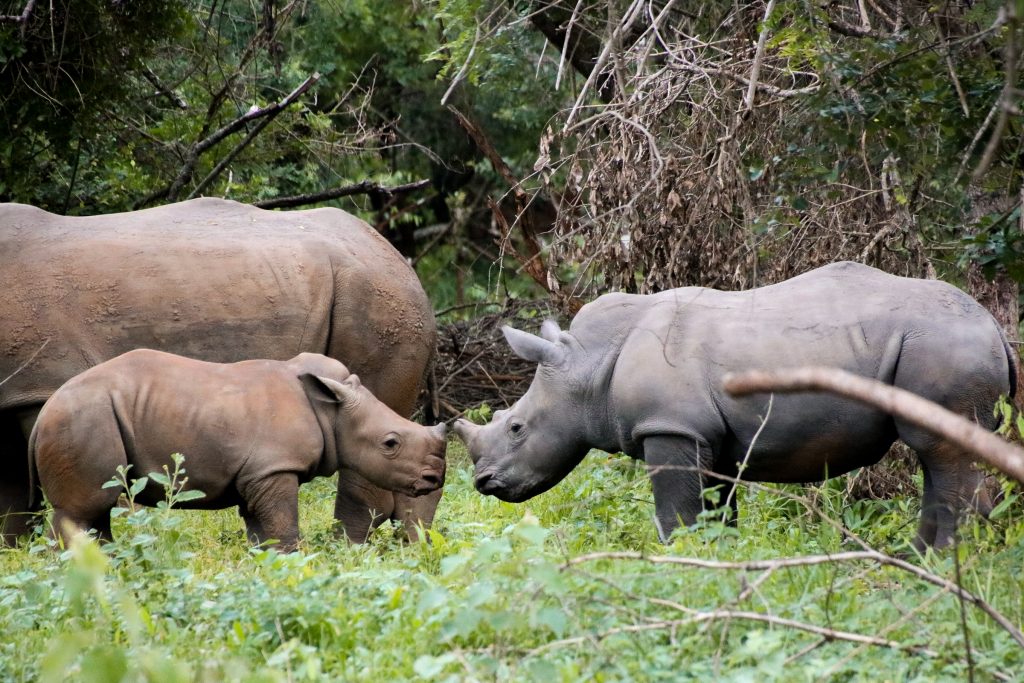
- Lake Mburo National Park, accessible from the main road from Kampala to Mbarara this national park sits at the heart of the longhorn cow rearing regions of central and southern Uganda. The park is a bit overgrown after elephants disappeared due to large scale poaching. Still, this is the only place in Uganda to see zebra. You can do walking and cycling safaris.
- Victoria Lake, in particular Mbamba Swamp, still has large swaths of reed swamps which are rich in birdlife. This is one of the places where you are almost guaranteed to find shoebill storks!

Quickly read on to find the best places to see your own favourite animals of Uganda! Including where to find shoebill storks…
We did not visit Kidepo National Park but we hear and see from other travellers that it is one of the best wildparks of Uganda with possible sightings of the Big-5 on open savannahs. However, it is a long ride to the north. We will have to come back to see it. On the other side of the tourism spectrum in Uganda is Bwindi National Park which we also did not visit. This is one of the most visited national parks in Uganda as it presents the ‘easiest’ access to gorilla tracking in the country, and maybe in the region.

When to visit Uganda to see wildlife?
Uganda is right on the equator. This means it doesn’t have winter and summer but rather dry and wet seasons. June to September is Uganda’s dry season. In December-January Uganda also sees a slightly drier season than the rest of the year. We were there in June and still had a rain shower now and then, although mostly not hindering the wildlife viewing. This may impact how much you may want to be camping in a tent though.
Accessibility of wildlife tracks in some of the parks can be limited during the wet season. Temperatures in Uganda range between a pleasant 25 and 30 degrees Celsius all year round. High season in Uganda still does not mean mass tourism, and we could always easily book or arrange accomodation on the spot in or nearby national parks. We understand that seasons do not signifcantly effect where and when you find shoebill storks in Uganda as they are resident birds.
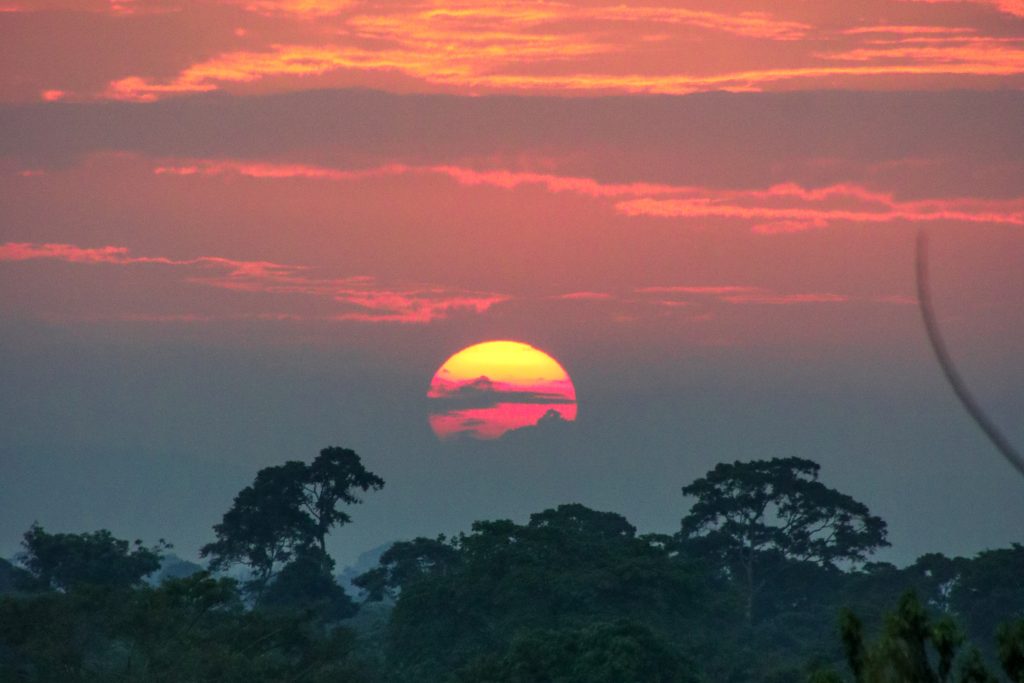
Top places to see the monkeys and apes of Uganda
We didn’t know before we started researching but Uganda is one of the best places in Africa to see a wide variety of monkeys and apes. There an impressive twenty different species of primates. We saw nine different species while we there, even though we did not even yet visit Kibale National Park which is the primate hotspot of Uganda.
I know, you want to know where to find shoebill storks, but hold on, these animals are just as interesting… the shoebill storks will follow, I promise.
1. Chimpanzee

For us it is not so much mountain gorillas, but wild chimpanzees that makes our first encounter with some of the great apes in Uganda. They live in big groups in forests throughout Uganda. A few groups are habituated to people and can be visited on a chimpanzee tracking.
- Where to see: Kaniyo Pabide Forest in the Murchison Falls National Park near the southern gate; starting point: Budongo Eco Lodge. Most organised tours will go to Kibale national park to track the chimpanzee groups there. We do recommend the MFNP-experience as the walk through the forest is easy and there seem to be few tourists around.
- How to see: Make a booking for any of the chimpanzee tracking experiences through the Uganda Wildlife Authority (UWA). Do bring good shoes and long clothing.
Also read: Self-drive safari in Murchison Falls NP
2. Black-and-White Colobus
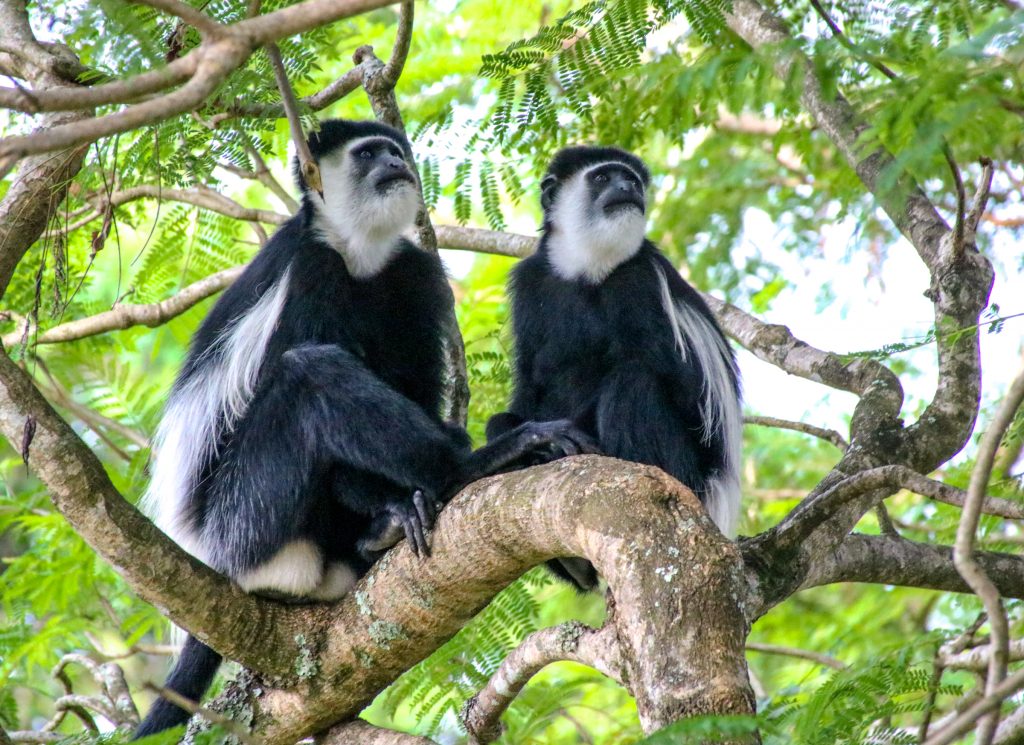
These creatures are energetic whirling pieces of long black and white fur. They live in large groups in forest environments. We come across while staying at Lake Nkuruba where a big group inhabits the grounds together with a bunch of vervet monkeys.
- Where to see: Lake Nkuruba Nature Reserve & Community Campsite
- How to see: Show up at Lake Nkuruba for lunch and a drink until you see the monkeys. Or stay the night and take a hike with community guides
3. Golden monkey
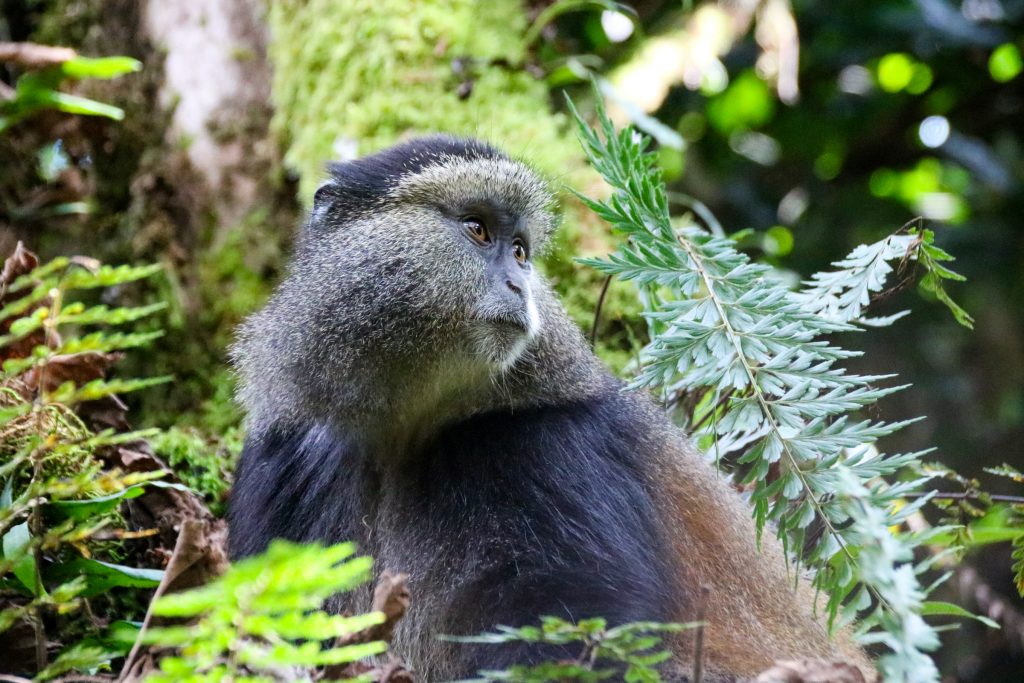
The golden monkeys are a curious specie. They only live in mountainous areas in the Virunga rangein southern Uganda and northern Rwanda. They are an endangered species and unique for being the only other primates living in gorilla country. There are only 2000 to 4000 golden monkeys left in the wild. The zones they inhabit are bamboo groves at a particular height, while they come down to the secondary forest now and then.
- Where to see: Mgahinga Gorilla National Park
- How to see: Book a golden monkey tracking through the Uganda Wildlife Authority (UWA) or directly at the UWA-office in Kisoro.
4. Vervet monkey
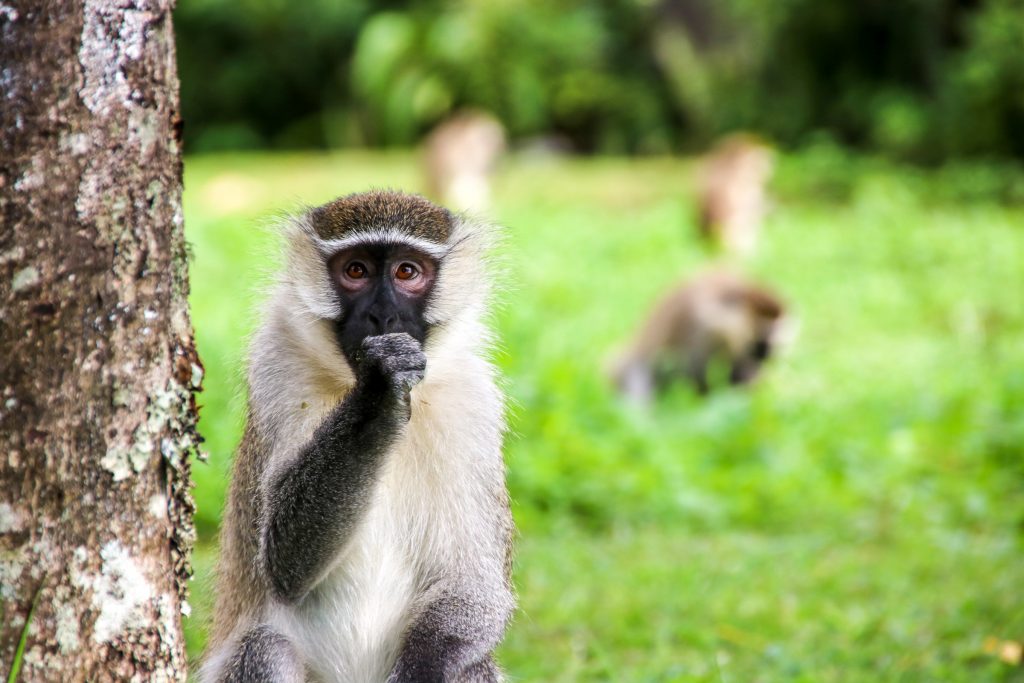
These little rascals are common to many places around sub-Saharan Africa. There is big group living at the Nkuruba Lake Nature Reserve, getting into rows with black-and-white colobus monkeys if they touch the ground. The ground is theirs; the colobus have the trees. Mind your lunch and backpack as they are little thieves…
- Where to see: Lake Nkuruba Nature Reserve & Community Campsite
- How to see: Show up at Lake Nkuruba for lunch and a drink until you see the monkeys. Or stay the night and take a hike with community guides.
5. Ugandan (Ashy) Red colobus

The Ashy Red Colobus is slightly more elusive than many other species. This characteristic monkey looks like he has rolled through the remains of a camp fire. Different from other red colobus species their colour is subdued and has ashen streaks throughout. The ashy red colobus is highly threatened with only 20.000 species left with most living in and around Kibale NP
- Where to see: the natural areas in the Fort Portal region. Good opportunities to see them is to do a locally guided Bigodi Nature Walk or by spending a bit more time around Lake Nkuruba Nature Reserve & Community Campsite.
- How to see: Book online to do the Bigodi Nature Walk, maybe combine it with other community activities or a visit to Kibale NP

Other primates to see in Uganda
- Grey-cheeked Mangabey – Can be spotted on the Bigodi Nature Walk
- Red-tailed monkey – Also called white-nosed monkey for obvious reason. Can be found as one of five primate species on the Bigodi Nature Walk
- Olive Baboons – You will quickly come across big groups of baboons when riding through any of Uganda’s national parks, and even outside those.
- Patas monkeys – These monkeys can be found in savannas. We saw them in the hills of Murchison Falls National Park, where the giraffes roam.
Mountain Gorillas – Many people come to Uganda specifically to see the mountain gorillas of Bwindi Impenetralbe national park or at Mgahinga Gorilla National Park. However, the costs for permits are sky-high. We didn’t see them and had a great time in Uganda without the feeling we missed out on something. If you do want to see them, book ahead online. In high season (June to September, the main dry season) you may need to book your gorilla tracking months ahead, especially in Bwindi NP.
Still wanting to know where to find shoebill storks, right? But there is much more to see. Patience, more on shoebill storks further below! But first some of the other great animals of Uganda.

Seven top sightings of ‘big game’ in Uganda
While of course Uganda is just the little brother or sister to wildlife power house countries like Kenya, Tanzania and South Africa, it is surprising to see how much of a genuine wildlife experience you can get in this compact country.
1. Lions of Uganda: living in trees!

Lions are spectacular animals to see anywhere throughout sub-Saharan Africa. But there is something special about seeing lions in Uganda, and especially in Queen Elizabeth National Park. There are several lion troops here that spent their lazy days hanging about in trees: a unique sight.
- Where to see: Lions can be seen in Murchison Falls National Park, Kidepo National Park and Queen Elizabeth National Park. The tree-climbing lions are particularly know to inhabit the Ishasha sector of QENP, though some may be seen in the northern parts of this national park too.
- How to see: If you drive yourself, ask at Ishasha’s park gate (coming from the north) for recent sightings of the tree-climbing lions. The guards are happy to point you in the right direction. If on a tour: dont worry, the guides will find them for you when you go to the Ishasha sector.
Also read: Tree-climbing lions in Queen Elizabeth NP, and more
2. Rothschild Giraffes: severely threatened

The Ugandan giraffes are an endangered giraffe species with estimated only 1500-2000 individuals left in the world. Only lives in Uganda and parts of Kenya.
- Where to see: The biggest concentration of Rothschild Giraffes in Uganda lives inside Murchison Falls national park. In particular on the northern bank, you will find large groups roaming the hills. You can easily spend a few hours here if you like them.
- How to see: Take the park trails immediately north of the Paraa ferry across the Nile, first north and then west towards the airfield. Take it slow, and you will be spotting giraffes sooner than later.
3. Elephants: the keepers of the bush

Elephants, elephants, and more elephants. These may be the one big animal we saw most often in Uganda, apart from kob antelopes and buffalo maybe. After years of decline the African Elephant is growing in numbers again in Uganda: there may be some 5000 elephants currently living in Uganda.
- Where to see: We saw elephants in both Murchison Falls national park and Queen Elizabeth national park. Taking a boat ride on either or both the Nile and Kazinga Channel will offer you some of the best elephant sightings you can get in Africa. Game driving across these parks will also most likely deliver a sighting or two of herds or single bulls roaming the plains or trekking towards water. Afternoon boat rides are recommended for elephant sightings: they will come to the water to cool off mid- to late-afternoon.
- How to see: You can book boat tours on both the Nile (MFNP) and Kazinga Channel (QENP) through either the UWA or a select number of private companies. In QENP you can go to Mweya Lodge to book your boat ticket. In MFNP you can go to the offices near the pier on the south bank near the Paraa ferry (where they are now building a bridge across the Nile). Be a bit earlier for boarding than your boarding time to get a front row seat on the left side of the boat.
4. Nile crocodiles

Crocodiles are the giants of the Nile and the lakes of Uganda. These animals can be up to 6 meters long and it is not uncommon to see 4 meter long specimens.
- Where to see: The best place to see nile crocodiles in Uganda is Murchison Falls national park on a boat ride towards the Murchison Falls. A good second is a boat safari on the Kazinga Channel (QENP)
- How to see: Take a seat on the side of the boat, sit back and focus your gaze on the edge of the water.

You are getting close to finding out where to find shoebill storks in Uganda … keep on reading!
Chameleons and lizards – It is not only big animals that make a safari or guided nature walk interesting in Uganda. We saw chameleons in Mgahinga NP and monitor lizards in Queen Elizabeth National Park. Also keep an eye out for turtles, butterflies and other smaller critters.
5. Rhino: success story of re-introduction

Rhinoceros were practically extinct in Uganda. During the days of Idi Amin widespread poaching and hunting reduced the numbers of all wildlife, and drive the rhinos to extinction. At the end of the 1990s an ambitious plan got under way.
- Where to see: Ziwa Rhino Sanctuary is just a few hours from Kampala just off the main road to the northwest. This 7000 hectare is fenced off and houses more than twenty closely monitored rhinos.
- How to see: You don’t necessarily need to book ahead to organise a rhino walk at the sanctuary. However, if you just show up it can be a while before a guide and rangers are available to take you along. We recommend to stay the night camping within the sanctuary grounds, or you can organise a cabin (do call ahead for availability). If you want to go around the sanctuary by car in stead of on foot, you need to take the guide with you in your own car.
6. Kob antelope

If you have been on wildlife safaris across Southern or Eastern Africa you may have come to expect to see large groups of impalas on the wide open plains. To our surprise, it was clearly a different antelope that we encountered in the national parks of western Uganda. Here the kob antelope reigns over the northern, wet savannahs reaching from Uganda to Western Africa.
- Where to see: You will mostly find large groups of kob in both Murchison Falls National Park and Queen Elizabeth National Park (and probably Kidepo, which we did not visit). In MFNP you will find them in the hills and on the plains of the northern part of the national park. In QENP it is on the Kazenyi plains where you will definitely come across herds of kob.
- How to see: Drive any track across the Kasenyi plains or northern MFNP and you will bump into them. Drive slow and carefully as they may sit on or cross the road unexpectedly, and you don’t want to literally bump into them!
Still curious where to find shoebill storks? Almost there!
7. Topi

As we had only travelled the safari-way around southern Africa, we came across a new type of curious-looking antelope: the topi, a variant of tsessebe. This animal, not unlike the wildebeest (which does not live in Uganda), leans so much towards ugly that it becomes beautiful again. We saw several topi with small foal.
- Where to see: We saw topi antelopes mostly in the hills and plains of Murchison Falls National Park mixing with kob and giraffe herds.
- How to see: Get yourself onto a game drive, self-driving or with a chauffeur and/or guide, and keep an eye out for them when you see giraffes around.
8. Defassa Waterbuck

Again, the defassa waterbuck is a particular variant of waterbuck that you will not find in southern Africa. Its distinctive curved horns for males and white markings on both males and females make for a striking appearance.
- Where to see: Most of our sightings of Defassa Waterbucks were in Queen Elizabeth National Park. It is a particular pretty sight to see them in and around the craters at the north end of QENP: check out Crater Gate and Cafe on the northern approach of the national park boundary. But you can also find them spread out through the more bushy part driving along the north bank of the Kazinga Channel.
- How to see: Keep an eye out while game driving, especially in parts with more shrubs
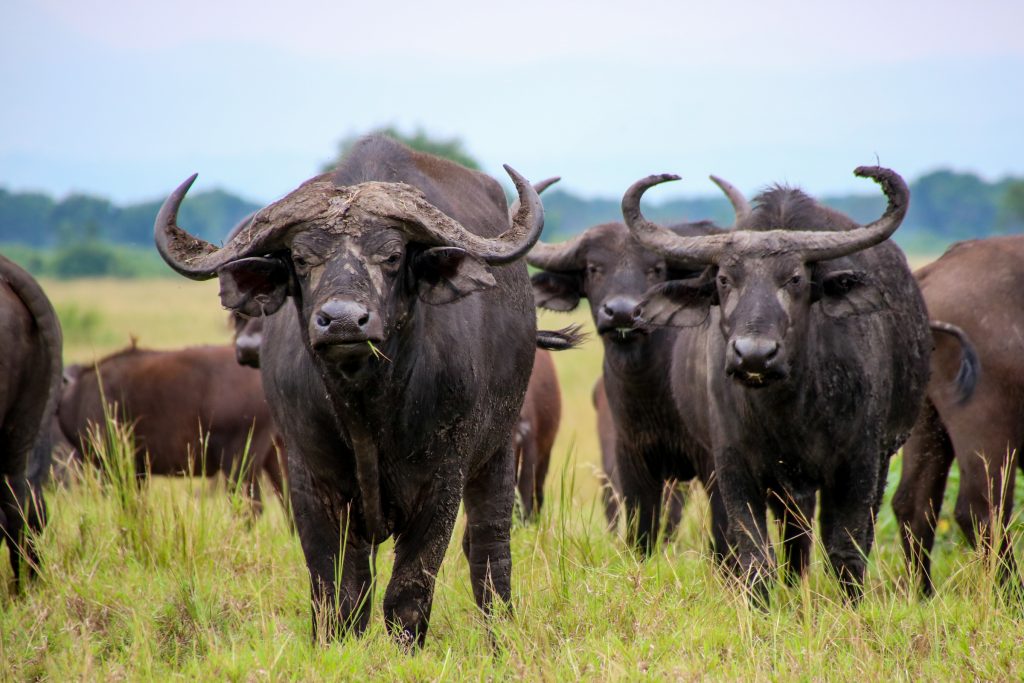
Other mammals you can see in Uganda
- Leopards – We just missed seeing leopards in Uganda. But you may find them! Two times they were gone or too far from the tracks (wchich you officially cannot leave while game driving the national parks!). The Kasenyi Pains in Queen Elizabeth National Park provides your best bet. If self-driving, ask around before and while driving for recent sightings.
- Hippopotamus – Hippos are an integral experience of Uganda boat safaris in Murchison Falls NP and Queen Elizabeth NP. While boating on the Nile or Kazinga Channel and from the shores of Edward Lake and Albert Lake you will see hundreds of them emerged in shallow water.
- Buffalo – Across MFNP’s and QENP’s plains it is almost 100% certain you will come across buffalo herds. Try a staring contest but do not agonise a herd.
- Warthogs – Often not far from buffalo herds in any of the national oarks of Uganda

- Oribi and Duikers – These smaller antelope species mix with herds of kob and you can find them spread out, some in pairs, across the plains. We mostly saw them in MFNP.
- Bushbuck – This pretty animal was more elusive to us than the waterbuck, but you may find them in similar places
- Zebra – There are not many parts of Uganda where you can see zebra. With just 3000 left, you will definitely find them in (but also outside the park gates) of Lake Mburo National Park. They seem to have a peaceful co-existence with domesticated Ankole long-horn cows that are herded here
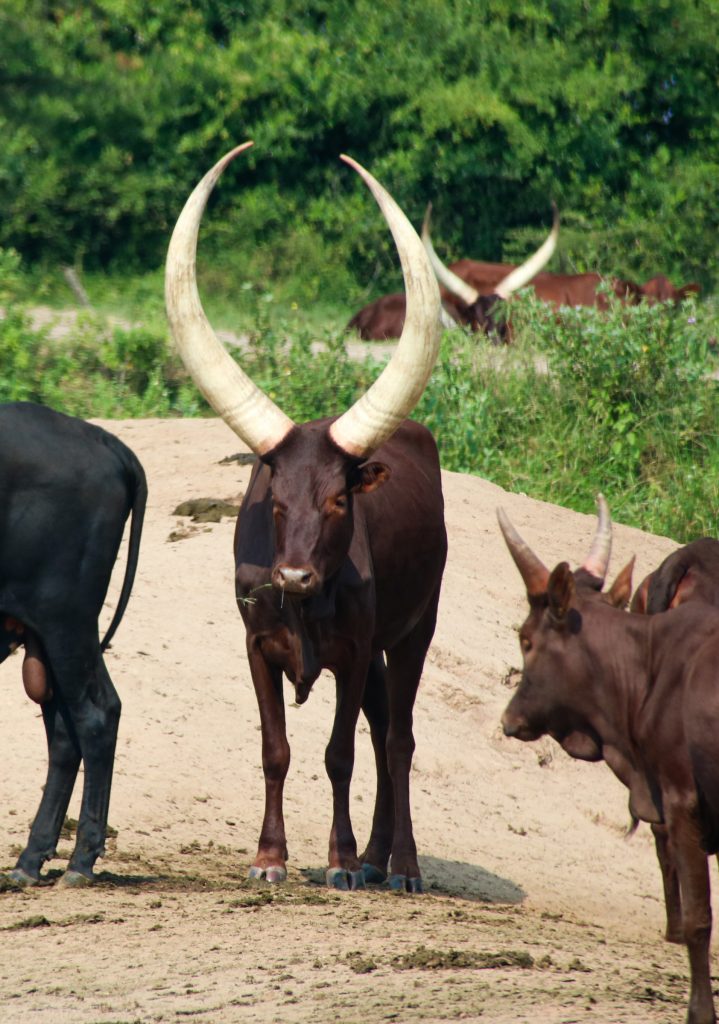
Ankole Long-horn cows – Although technically not wildlife, the Ankole Longhorn Cow is a remarkable animal to behold. They are an integral part to local life and culture of the Bahima people. You will most likely come across large groups of cows while driving along the Kampala-Mbarara corridor. Large herds graze around Lake Mburo National Park and Ziwa Rhino Sanctuary. Basing yourself on their campsites will definitely deliver one or more opportunities to see these extraordinary animals.
You are finally there! Now: where can you find shoebill stork and many other birds in Uganda!
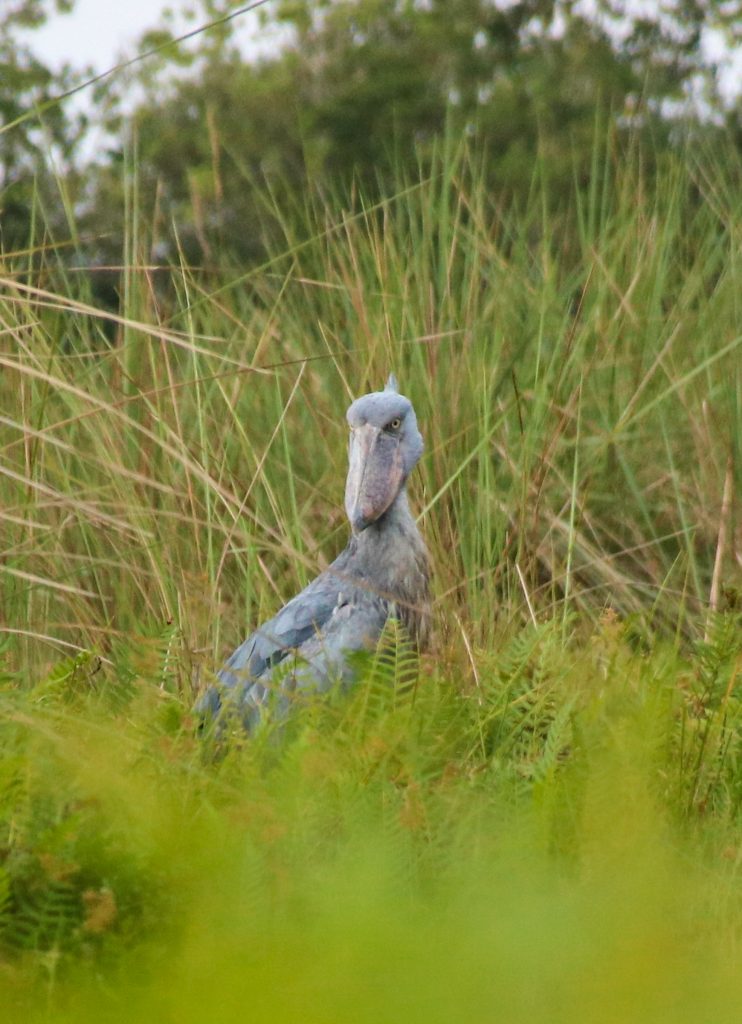
Enigmatic Birds of Uganda
1. Shoebill Stork: where to find them!

One the reasons to visit Uganda was to find this pre-historic, giant of a bird! Ever since we saw them in a BBC Earth documentart by David Attenborough we got fascinated by them. When we heard that there are several places wehre we could see the shoebill stork in Uganda, we went for it. SO finally: here is where you can find shoebill storks in Uganda.
- Where to see: There are two places that offer near-guaranteed sightings of shoebill stork in Uganda: The Mbamba wetlands on the shores of Lake Victoria (across from Entebbe by ferry), and Ziwa Rhino Sanctuary. We also saw a couple on the shores of Lake Albert (on the so-called shoebill track!), but this was treated as if it were a lion sighting by top end guides we met on the spot. So you can’t count on that.
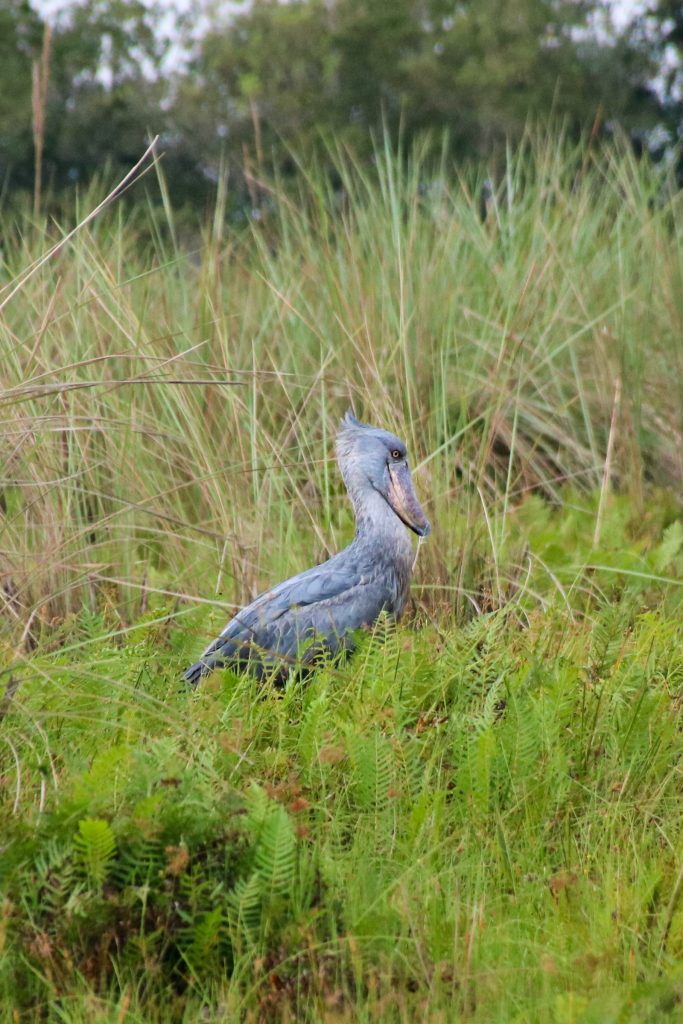
- How to see: You can go directly to the landing zone at Mbamba Swamp and organise a guide and boat on the spot, or organise a tour from Entebbe. We got Nkima Forest Lodgeto put in a call for us to get a private boat which was lovely! Staying the night at Nkima Lodge also helps getting there early, making sure you are on the water before any groups from Entebbe. At the Ziwa Rhino Sanctuary you can organise a shoebill tracking on the spot (be patient if there is no guide immediately available) or beforehand through the website. Stay the night to combine it with rhino tracking and not feel hurried.
2. Great Blue Turaco
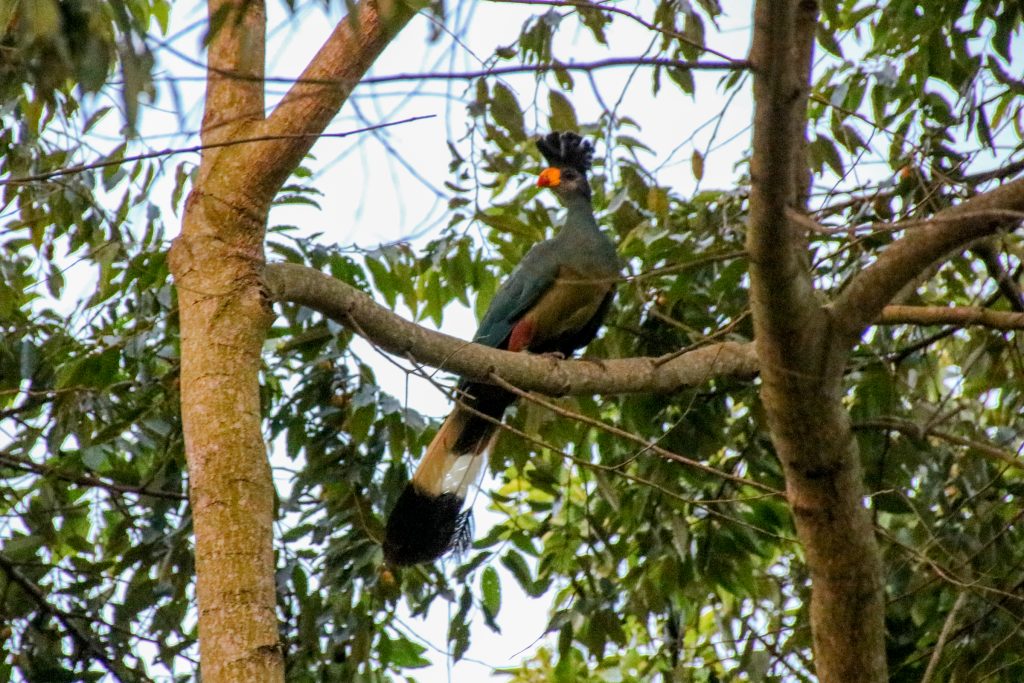
Uganda is prime territory to see the Great Blue Turaco. This bird is the biggest of the turacos and one of the birds you have to try to find when you are in Uganda. It lives along the equator in forests across western Africa, and central Africa.
- Where to see: Bigodi Nature Walk near Kibale national park; and Nkima Forest Lodge
- How to see: Book a nature walk with local guides at Bigodi Nature Walk or stay a night and wander the grounds at Nkima Forest Lodge (you can also camp near the lodge and then use the living room, diner facilities, and have full wandering rights to the grounds).
3. Crested Crane: the national bird
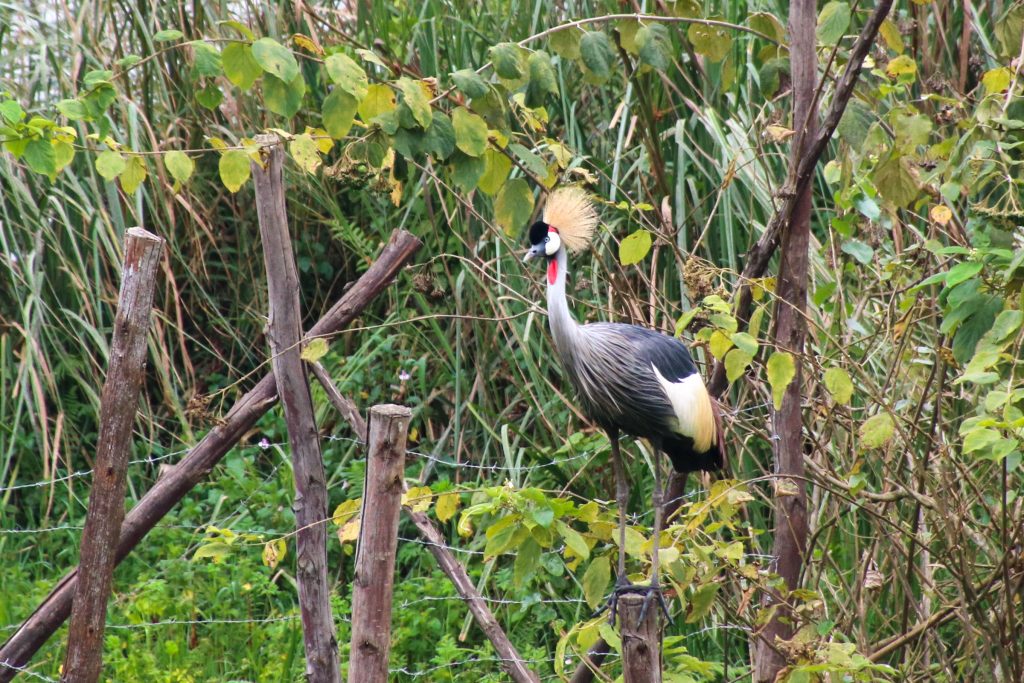
As the crested crane – or grey crowned crane – is the national bird of Uganda we had expected to see it throughout our three weeks in Uganda. But it wasn’t until late in our trip we saw our first ones. Although it is a relatively well-known bird being kept in captivity for its beauty, its habitat is under threat. The crested crane is considered an endangered species.
- Where to see: It should be possible to see crested cranes in Murchison Falls National Park and other open plains areas although we did not. Look for them by water in relatively dry regions, along lake and river shores and wetland areas. We saw some on the fringes of Lake Bunyonyi in the most southern point of Uganda, near Rwanda
- How to see: Apparently you need to be a bit lucky. Another option is to ask around locally where to may be found. Alternatively, get yourself a specialised birding guide
4. Orange Weaver Birds

Weaver birds are striking and loud birds living in groups. They built characteristic hanging nests woven from grass. Often huge groups will weave their nests together in trees making for an extraordinary sight.
- Where to see: These cute, chattering birds can be found throughout Uganda. Our best sightings were at Bigodi Nature Walk where a large group inhabited a few trees, building their nests at the starting point of the walk. And at Lake Bunyonyi where we had a weaver bird building his nest in the reeds right in front of our cabin.
- How to see: You don’t have to look far or put extra effort in to find weaver birds in Uganda. Although easy to see, their speed and jittery movements make it difficult to photograph them.
5. Malachite Kingfisher

Although quite common birds, malachite kingfishers are not always easy to find if you don’t put yourself out on a river or wetland area. These beautiful kingfisher birds dive from a regular spot a short distance above the water to catch fish.
- Where to see: Our top encounter with a malachite kingfisher was in Mbamba Swamp while searching for Shoebill Storks.
- How to see: It pays to go on a dedicated birding tour on the water to see these birds. Their small size, water habitat and quick flight needs a slower pace than regular game driving tours.
6. Carmine bee eater and other bee eaters
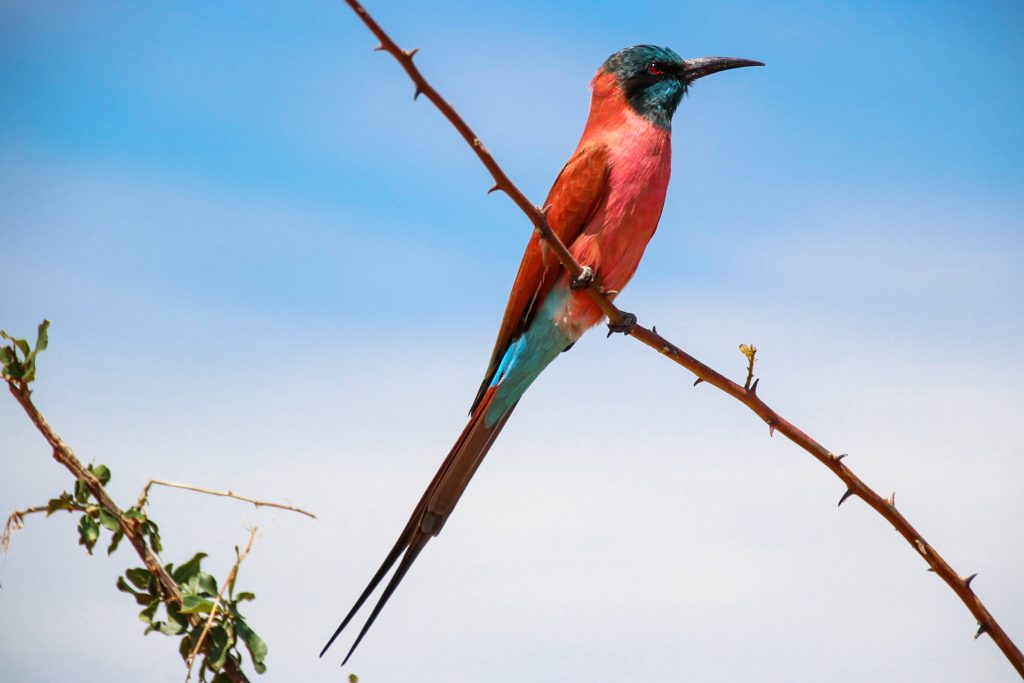
Bee eaters are the most striking birds of the African plains. With their bright colours they stand out when they fly around catching their prey mid-air
- Where to see: Our most striking sightings were in Murchison Falls National Park and Nkima Forest Lodge. At dusk in Nkima Forest Lodge when a large group clouded the air catching insects in unison against the setting sun. In MFNP, but also in QENP, bee eaters are common occurrences on the open plains.
- How to see: Get yourself out into the national parks and you will most likely see these birds on game drives. It is not unlikely if you see them even if you don;t put in specific effort to spot them.
7. Pied Kingfisher

The most commonly sighted bird of Uganda is the Pied Kingfisher, standing out in black and white. For us, this one felt like it was the national bird, so often did we see it, and in so many different places. With only a bit of water around, these birds will seemingly thrive.
- Where to see: Anywhere in Uganda
- How to see: Just be in Uganda and you will see them
8. Open-Billed Storks

Although there are many stork and heron species in Uganda, this one stands out for being slightly different from the rest. With is beak opening up in the middle while its pint closes again you may first think there is something wrong with them. But there is not.
- Where to see: These storks are common around Uganda near any water. Our best sightings were at the pond of Via Via guesthouse in Uganda, as well as on Kazinga Channel (QENP) and the shores of Lake Albert (MFNP)
- How to see: Sit back at the shore of a lake and let them come to you. I recommend some fruit juice to go with that on the excellent terrace of Via Via guesthouse.
Other birds we saw in Uganda

- African Fish Eagle – on the Nile river, MFNP
- Grey-headed kingfisher – different plcaes, also in Entebbe
- Saddle-billed storks – notuncommon, for sure on the Kazinga channel
- Maribou Storks (Greater Adjutant) – in the streets of Entebbe as well as in QENP
- Yellow-Billed Storks – common in many places along water
- Hamerkop – clear sighting both in Entebbe and Mbamba swamp , more common than you might think
- White herons – everywhere and anywhere
- Purple herons – on any lakeside or water edge
- Southern Red Bishop – sighting in MFNP
- Blue-headed coucal – sighted on Lake Albert shores
- African Jacana (locally called the ‘Jesus’ bird as it walks on water) – sightings can be expected in Mbamba Swamp
- Abyssinian Ground Hornbill – we saw this one once, in MFNP
- Hadada Ibis – quite common, we had our best sightings at Lake Bunyonyi and Bigodi nature walk
- Sacred Ibis – in many different places
- Bustards (Hartlaub’s Bustard) – in MFNP
- Flamingo – in MFNP and QENP, but probaly on Lake Victoria toot
- Black-and-White Casqued Hornbill
- African Gray Hornbill – seen in MFNP and near Lake Victoria
- Cormorants MFNP
- Nile geese – common, saw them in many places; the weird thing is that they are now a common occurence in The Netherlands too!
- Blue herons – everywhere
- Mousebirds – seen at Lake Bunyonyi
- And numerous other unidentified birds including humming birds, eagles and hawks, singing birds, sparrows and finches, water birds, fowl, etcetera

